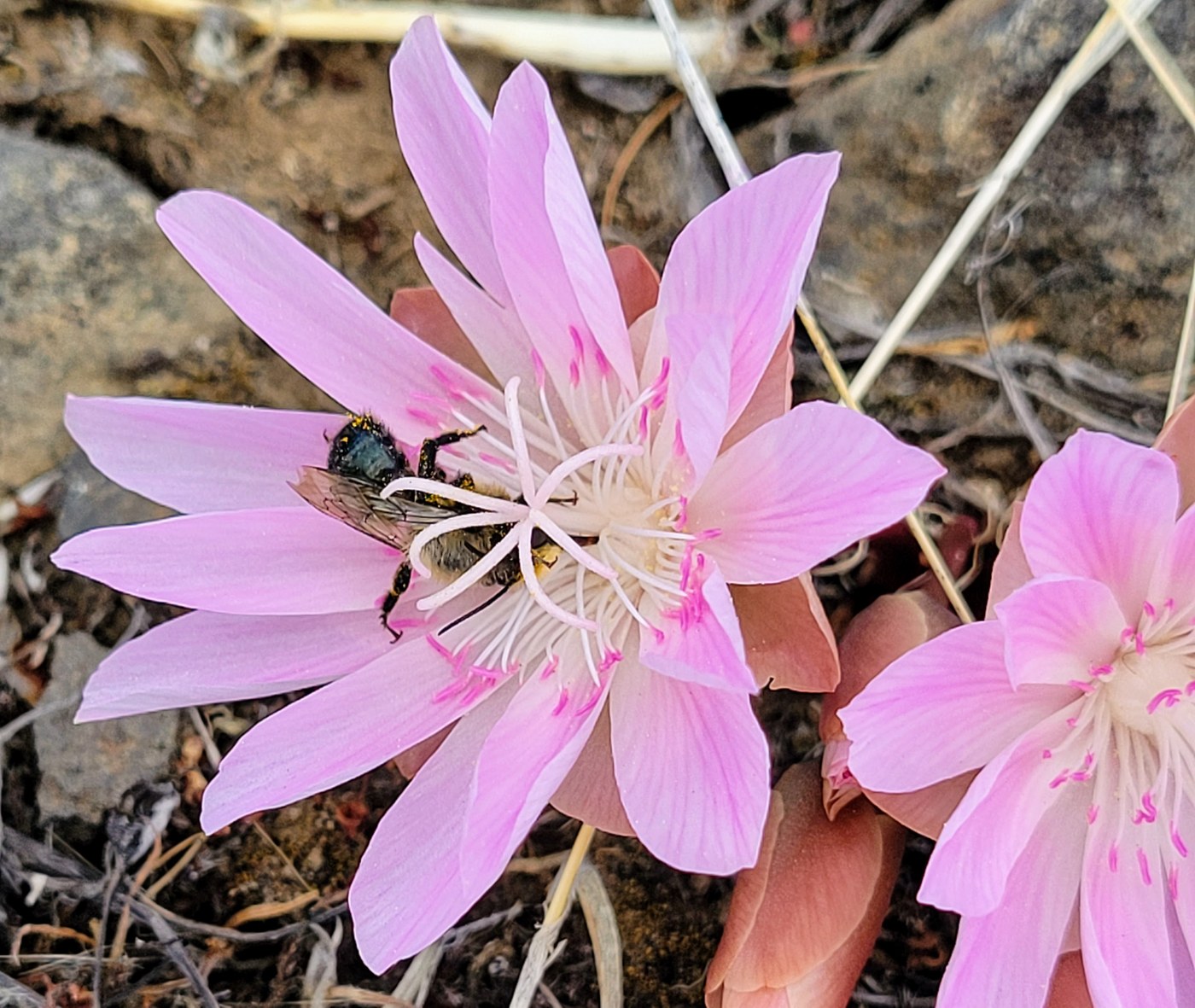Kay, Paul, Maggie, and John joined me for a Mountaineers hike up Westberg, west on the ridge road, a little dip down into South Riggs Canyon, and the Boy Scout trail on our return (see attached caltop for the 14 mile route). The large amounts of winter snow and the sunny spring has paid off, there are lots of flowers everywhere we hiked. We saw 64 species of flowering plants (Paul's list of the flowering plants is at the bottom, I like hiking with naturalists).
What is especially nice is that there are different flowers in abundance in different areas. There are thick areas of Gairdner's penstemon (picture 3), thick, large, and colorful buckwheats (picture 1), balsamroot (thickest near woods on the ridge and at the top of the Westberg), paintbrush, showy phlox, bitterroot (picture 4, more than I have ever seen on a hike), yellow desert daisies/fleabane, larkspur, and lots of antelope brush lighting up the hillsides on the Westberg. The 2 minute video will give you a little feel for the flowers. There were only a few royal penstemons, but they are striking (picture 2).
WILDFLOWERS (64 species)
white (18)
chokecherry (Prunus virginiana)
bitter cherry (Prunus emarginata)
white campion / evening catchfly (Silene latifolia) — introduced from Europe
wax / DESERT currant (Ribes cereum)
showy phlox (Phlox speciosa)
common yarrow (Achillea millefolium)
milk-vetch, species uncertain (Astragalus sp.) —
46 species of milk-vetch grow in Washington, including 20 in Kittitas County!
tufted saxifrage (Saxifraga cespitosa)
saxifrage, probably Clayton’s (Micranthes, probably fragosa)
sagebrush stickseed (Hackelia diffusa)
western serviceberry (Amelanchier alnifolia)
prairie-star, species uncertain (Lithophragma sp.)
panicled death-camas (Toxicoscordion / Zigadenus paniculatum)
lance-leaved spring-beauty (Claytonia lanceolata)
Siberian spring-beauty (Claytonia sibirica)
large false Solomon’s seal (Maianthemum racemosum)
star-flowered Solomon’s seal (Maianthemum stellatum)
Sitka mountain-ash (Sorbus sitchensis)
yellow (20)
salsify (Tragopogon dubius)
bitterbrush / antelope brush (Purshia tridentata)
Douglas’s buckwheat (Eriogonum douglasii)
thyme-leaf buckwheat (Eriogonum thymoides)
arrow-leaf buckwheat (Eriogonum compositum)
Carey’s balsamroot (Balsamorhiza careyana)
Hooker’s balsamroot (Balsamorhiza hookeri)
Carey’s x Hooker’s hybrid balsamroot (Balsamorhiza careyana x hookeri)
desert yellow daisy (Erigeron linearis)
nineleaf desert-parsley / biscuitroot (Lomatium triternatum) — or a split-off species
barestem desert-parsley / biscuitroot (Lomatium nudicaule)
tall western groundsel (Senecio integerrimus)
tansymustard, species uncertain (Descurainia sp.)
hawksbeard, species uncertain (Crepis sp.)
Columbian puccoon (Lithospermum ruderale)
nodding microseris (Microseris nutans)
large-flowered agoseris (Agoseris grandiflora)
heart-leaf arnica (Arnica cordifolia)
holly-leaf / tall Oregon-grape (Mahonia aquifolium)
field mustard (Brassica rapa)
reddish: pink to red to red-purple (10)
common snowberry (Symphoricarpos albus)
mountain snowberry (Symphoricarpos oreophilus)
Gairdner’s penstemon (Penstemon gairdneri)
bitterroot (Lewisia rediviva)
harsh paintbrush (Castilleja hispida)
old man’s whiskers (Geum triflorum)
redstem stork’s bill (Erodium cicutarium)
Columbia / small-flowered rockcress (Boechera pauciflora)
big-head clover (Trifolium macrocephalum)
rose, bald-hip or Nootka or pear-hip (Rosa gymnocarpa or nutkana or woodsii)
bluish: blue to violet to blue-purple (14)
blue mustard (Chorispora tenella) — introduced from SW Asia
lupine, probably elegant or prairie (Lupinus, probably lepidus, variety lobbii or aridus)
lupine, probably silky or silvery (Lupinus, probably sericeus or argenteus)
royal / showy penstemon (Penstemon speciosus)
large-flower Triteleia / Douglas's brodiaea (Triteleia grandiflora / Brodiaea douglasii)
western blue iris (Iris missouriensis) — this is a native!
two-spike larkspur (Delphinium distichum)
larkspur, species uncertain (Delphinium sp.) —
19 species of larkspur grow in Washington, including 11 in Kittitas County!
bluebells, sagebrush or shade or trumpet (Mertensia amoena or umbratilis or longiflora)
ball-head waterleaf (Hydrophyllum capitatum)
shaggy daisy (Erigeron pumilus)
few-flowered pea (Lathyrus pauciflorus)
thread-leaf phacelia (Phacelia linearis)
small-flowered blue-eyed Mary (Collinsia parviflora)
green (1)
Thompson’s paintbrush (Castilleja thompsonii)
brown (1)
chocolate tips (Lomatium dissectum)
BIRDS
Red-tailed Hawk
Steller’s Jay
Yellow-rumped Warbler
Western Meadowlark
American Kestrel
Common Raven
Chipping Sparrow
Vesper Sparrow
Sagebrush Sparrow
Western Bluebird
Spotted Towhee
Whitebreasted Nuthatch
Red-breasted Nuthatch
Dusky Grouse
Mountain Chickadee
Willow Flycatcher
Black-headed Grosbeak
Dark-eyed Junco
Osprey
Northern Harrier
BUTTERFLIES
Ochre Ringlet
unidentified white







Comments
Skip32 on Manastash Ridge - Observatory Road, Manastash Ridge - Westberg Trail, Manastash Ridge - Boy Scout Trail
Beaufiful photos, nice report. Did any of your group pick up ticks?
Posted by:
Skip32 on May 19, 2021 09:11 AM
AlpsDayTripper on Manastash Ridge - Observatory Road, Manastash Ridge - Westberg Trail, Manastash Ridge - Boy Scout Trail
Thanks! Not 1 tick, and no snakes (it was in the upper 50's).
Posted by:
AlpsDayTripper on May 19, 2021 03:39 PM
chikamin on Manastash Ridge - Observatory Road, Manastash Ridge - Westberg Trail, Manastash Ridge - Boy Scout Trail
The common name of Squaw Currant is offensive to the First Nations. The preferred common name is Desert Currant or Wax Currant.
Posted by:
chikamin on May 20, 2021 06:34 AM
AlpsDayTripper on Manastash Ridge - Observatory Road, Manastash Ridge - Westberg Trail, Manastash Ridge - Boy Scout Trail
Thanks for pointing that out. Sorry, I did not read/edit the list before I pasted it into the report. I have changed that common name. Is there any movement to change the scientific names for any of the flowers from the white men who "first discovered" them to a name used by the people(s) native to the land? Instead of Lewis' I am going to start using Sacagawea's, she saw these flowers before Lewis ever did.
Posted by:
AlpsDayTripper on May 20, 2021 06:52 AM